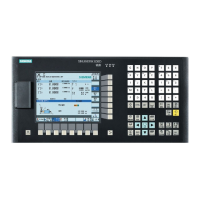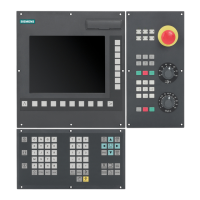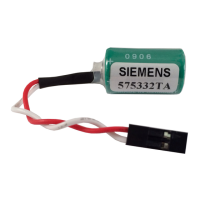Function Manual
140 01/2017
Tool measuring in JOG
Measuring principle
The employed tool is traversed to the probe by the user in "JOG" mode using the traverse keys or handwheel. The
measuring program controls the real measurement sequence with a second approach of the probe and further positioning. In
the end the tool offsets are entered.
Advantage: The entered offset values before measuring the tool can deviate entirely from the actual values. The tools must
not be "pre-measured".
-measured", not its wear.
Softkeys and templates are provided for use by the user in "JOG" mode. This supports the user during tool measuring.
SINUMERIK 808D/SINUMERIK 808D ADVANCED Programming and Operating Manual
Note
The PLC user program must be created
with the necessary sequences. The functionality is not available beforehand.
Extreme caution must be taken when approaching the probe. The probes only have a limited deflection path. They will be
damaged or destroyed if this is exceeded! Observe the machi
ne manufacturer's instructions!
In particular, the approach speed should be reduced to such an extent that the probe can always be stopped promptly.
"Rapid traverse override" may not be active.
The screen forms provided and the sequence depend on the technology. Accordingly, the following used tool types can be
measured:
● Milling tool (geometry length 1 and geometry radius)
● Drill (geometry length 1)
The screens initially include the active tool T and the active offset number D for the target of the measurement result entry. A
different tool can be specified by the PLC via the interface, or the user can enter a different tool T and/or offset number D.
Note
If a tool or an offset number different to the active values has be
en entered, this must first be made known to the NC for
working after measurements have been made with this tool/tool offset, e.g. by programming and start in "MDA" mode. Only
then can the control unit calculate the correct tool offsets.
A
is automatically entered into the GEO component of the active/specified tool offset D of the
active/specified tool, and the associated "wear" and "adapter" components are deleted.
When measuring the
it is assumed that no further offset is applied to the axes of the cutter radius level (values
in the axes of the "adapter" component and GEO lengths 2 and 3 are equal to zero). The result for the radius is entered in
the "geometry" component. The associated "adapter" and "wear" components of both axes of the level are deleted.
The tool measuring probe is a touch probe at a fixed location or is swiveled into the working area by means of a mechanical
device. If the probe plate is of rectangular design, the edges should be aligned parallel to the axis. The tool/calibration tool is
traversed against the measuring probe. The probe must be calibrated before a measurement is taken. This means that the
precise probe triggering points in relation to the machine zero are known.

